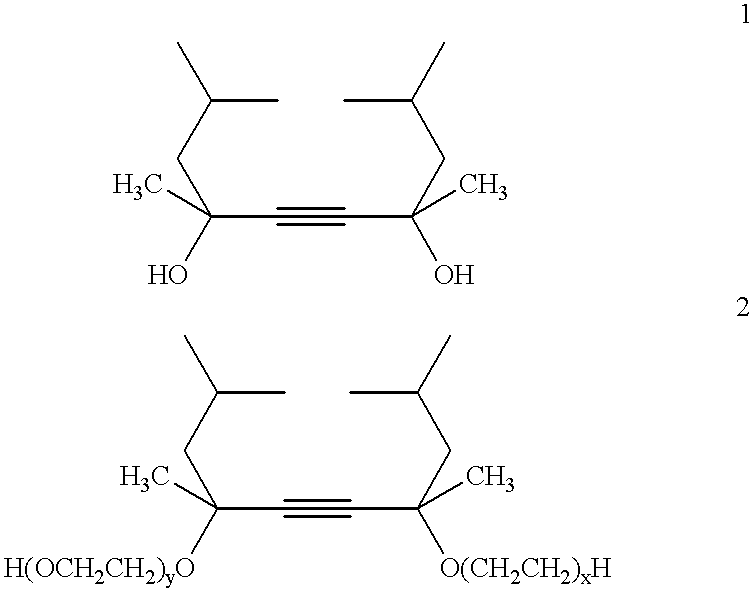Acetylenic diol ethylene oxide/propylene oxide adducts and processes for their manufacture
a technology of acetylenic diol alkylene oxide and ethylene oxide, which is applied in the direction of surface-active detergent compositions, detergent compositions, organic chemistry, etc., can solve the problems of poor dynamic surface tension reduction, inefficiency during formulation, defects during application, etc., to reduce reduce the ability to formulate water-based compositions, and reduce the effect of equilibrium and dynamic surface tension
- Summary
- Abstract
- Description
- Claims
- Application Information
AI Technical Summary
Benefits of technology
Problems solved by technology
Method used
Image
Examples
example 1
This example illustrates that two mole propoxylates of acetylenic diol ethoxylates can be prepared with high selectivity when using trialkylamine catalysts. In this example, the preparation of the 7 mole propoxylate of Surfynol® 465 surfactant, which is the 10 mole ethoxylate of 2,4,7,9-tetramethyl-4-decyne-4,7-diol, was attempted.
A 1000 mL autoclave was charged with Surfynol® 465 surfactant (300 g, 0.45 moles) and dimethylethylamine (53.7 g, 0.73 moles). The reactor was sealed, purged free of air with three nitrogen pressure-vent cycles, then pressured to 100 psig (6.7 bar) with nitrogen and heated to 120° C. Propylene oxide (183 g, 3.15 moles) was added over a period of 70 minutes by means of a syringe pump. At the completion of the addition, the reaction mixture was heated for an additional 12 hr at 120° C. The reactor contents were cooled and discharged. The product was heated under vacuum to remove volatiles (unreacted PO and catalyst); 68 g of material were removed.
Matrix assi...
examples 2-5
Example 3 illustrates the preparation of the 3.5 mole ethoxylate of 2,4,7,9-tetramethyl-5-decyne-4,7-diol capped with 2 moles of propylene oxide using trimethylamine catalyst and a preformed ethoxylate. The 3.5 mole ethoxylate of 2,4,7,9-tetramethyl-5-decyne-4,7-diol is commercially available from Air Products and Chemicals, Inc. and is marketed as Surfynol® 440 surfactant.
A 1000 mL autoclave was charged with Surfynol® 440 surfactant (400 g, 1.05 moles) which had previously been dried by heating under nitrogen. The reactor was sealed and pressure checked, the air was removed with three nitrogen pressure-vent cycles, and trimethylamine (2.7 g, 0.5 wt % of final reaction mass) was added by means of a gas tight syringe. The reactor was pressured to 100 psig (6.7 bar) with nitrogen and heated to 100° C. whereupon propylene oxide (122 g, 147 mL, 2.10 moles) was added at a rate of 1.0 mL / min by means of a syringe pump. At the completion of the addition, the reactor contents were stirred a...
examples 6-21
These examples illustrate the preparation of ethylene oxide / propylene oxide derivatives of 2,4,7,9-tetramethyl-5-decyne-4,7-diol (designated S104) and 2,5,8,11-tetramethyl-6-dodecyne-5,8-diol (designated S124) using BF3 catalyst. To our knowledge a procedure for the preparation of ethylene oxide / propylene oxide derivatives of acetylenic diols using Lewis acids such as BF3 has not previously been disclosed. The procedure is illustrated for the preparation of the 5 mole ethylene oxide, 2 mole propylene oxide adduct of 2,4,7,9-tetramethyl-5-decyne-4,7-diol (S104) in which the EO and PO units are randomly situated along the alkylene oxide chain.
A 1000 mL autoclave was charged with the 1.3 mole ethylene oxide adduct of 2,4,7,9-tetramethyl-5-decyne-4,7-diol (313 g, 1.1 moles; Surfynol 104 surfactant from Air Products and Chemicals, Inc.) which had previously been dried by heating under vacuum. The reactor was sealed and pressure checked, the air was removed with three nitrogen pressure-ve...
PUM
| Property | Measurement | Unit |
|---|---|---|
| Temperature | aaaaa | aaaaa |
| Pressure | aaaaa | aaaaa |
| Substance count | aaaaa | aaaaa |
Abstract
Description
Claims
Application Information
 Login to View More
Login to View More - R&D
- Intellectual Property
- Life Sciences
- Materials
- Tech Scout
- Unparalleled Data Quality
- Higher Quality Content
- 60% Fewer Hallucinations
Browse by: Latest US Patents, China's latest patents, Technical Efficacy Thesaurus, Application Domain, Technology Topic, Popular Technical Reports.
© 2025 PatSnap. All rights reserved.Legal|Privacy policy|Modern Slavery Act Transparency Statement|Sitemap|About US| Contact US: help@patsnap.com



